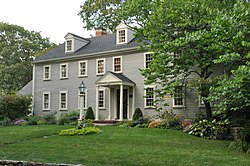William Parker House
William Parker House | |
 | |
| Location | Reading, Massachusetts |
|---|---|
| Coordinates | 42°30′35.29″N 71°6′28.51″W / 42.5098028°N 71.1079194°W |
| Built | c. 1796; 1910 |
| Architect | Willard P. Adden (1910) |
| Architectural style | Federal |
| MPS | Reading MRA |
| NRHP reference No. | 84002791[1] |
| Added to NRHP | July 19, 1984 |
The William Parker House is a historic house at 55 Walnut Street in Reading, Massachusetts. The 2+1⁄2-story wood-frame house was built c. 1796, was expanded early in the 19th century into a two family residence, and converted back into a single family in the early 20th century. It is notable for its association with William Parker, a dissenter from the doctrines espoused by the local Congregational Church. In 1849 he joined with other members of his extended family in splitting the congregation.[2]
In 1910 the house was purchased by Walter Scott Hopkins, a Boston merchant. Hopkins hired a local architect, Willard P. Adden, to return the house to its original single-family configuration and restore and renovate the house for use as a family home. Hopkins only owned the house for a few years before selling it to Adden c. 1916, though he too only lived there briefly, moving in 1918.[3][4][2] Adden later moved to Woburn Street.
The house was listed on the National Register of Historic Places in 1984.[1]
See also
[edit]- National Register of Historic Places listings in Reading, Massachusetts
- National Register of Historic Places listings in Middlesex County, Massachusetts
References
[edit]- ^ a b "National Register Information System". National Register of Historic Places. National Park Service. April 15, 2008.
- ^ a b "NRHP nomination for William Parker House". Commonwealth of Massachusetts. Retrieved 2014-02-17.
- ^ Howard V. Bowen, "The Story of Two Remodeled Farmhouses" in American Homes and Gardens 8, no. 10 (October, 1911): 365-370.
- ^ "Ancient Abode at Reading" in Boston Daily Globe, March 10, 1912, 6.



